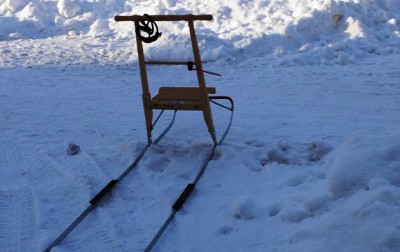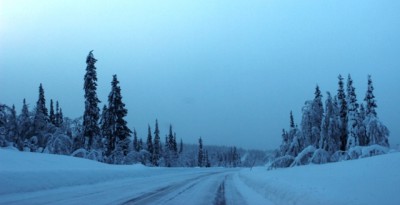Kiruna people love their motor vehicles. Every kind – classic cars, trucks, vans, tractors. Such is the obsession that even children have special dispensation to drive – a kind of car which pretends to be a farm vehicle and is supposed to have a low speed engine (usually a very noisy one). And yet, the transport of choice over a longer period has to be the well-named ‘Spark’, truly a transport of delight.
I don’t know how long they’ve been around, but long enough for there to be ‘Spark parking areas’ in town. They are most often used by elderly women, and so are seen as a kind of walking stick in the snow, but they are an extremely practical item for anyone in a climate of cold snow – why carry your shopping when you can slide it home? Uphill a Spark enables you to push shopping you wouldn’t want to carry. Downhill, a Spark delivers your shopping home as fast as a car.
The enemy of the Spark is grit. When the temperature rises and the council put grit on the pavements in case they turn to ice, the grit brings a Spark to a grinding halt. When we first moved here grit was spread on only half the pavement for this reason. These days it’s spread everywhere so the new gritters obviously don’t use a Spark.
I’ve discovered that the best way to be taken for a local is to use a Spark. If you want to blend in then using a Spark will do it. It announces you are not a visitor, and that you’re probably over 70. Cars are even more likely to stop for you. It’s a tremendous disguise for a would-be burglar – no-one would suspect anyone lurking around on a Spark.
So a harmless form of slow transport for the elderly – why would you want one of these?
Just before Christmas our car had a flat battery. We discovered it ten minutes before the shops shut for the four day Christmas break. We realised we had no battery charger. We called the garage who apologised it would take them 20 minutes to come out (as it was a Sunday this seemed pretty good to us), and then we realised if there was something wrong with our battery we would need a charger to keep us mobile over the coming days.
By now it was eight minutes before the shops shut. I kicked off down the street on my Spark. Fortunately, there was no new grit and the Spark flew downhill. Recklessly ignoring the rights of pedestrians on the pavement, I careered over humps of snow, manoeuvring my way across crossroads, reaching the shopping centre at two minutes to closing. After tying up my Spark (one minute) I entered the shop as they were dimming the lights. I made my way to the darkened till, clutching the item to my chest. I felt I had won the lottery. There are times when a Spark is all you need.



